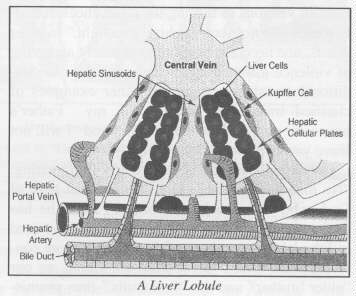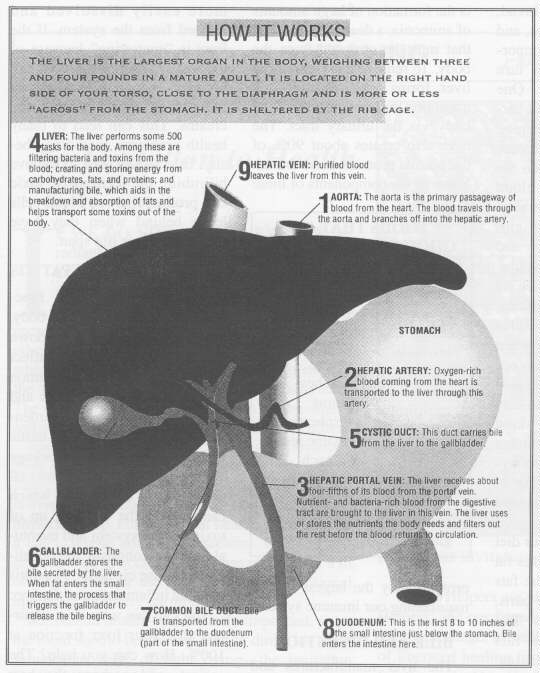

| rosanista.net | ||
| Simplified Scientific Christianity |


This is what earlier peoples called the liver. They recognized that the liver was important to their health and could see the basic relationships between its function and how they felt. Their view of the liver included a belief that the liver was the seat of our emotions and courage. Liver interpretation-reading the liver much as people read palms — even spread from Mesopotamia to Greece and Rome. Through occult anatomy, we know that reference was being made to the desire body counterpart of the physical liver. Certainly earlier people were correct in understanding the liver's importance to our bodies.
The liver is so important that if it is not working right, other organs begin working harder in order to make up for what the liver is not doing. The other organs tire, resulting in many of the symptoms of illness. Many health professionals believe that an out-of-order liver is one component of many of the sicknesses we experience.
If we imagine the veins and arteries that carry our blood as a closed circuit racetrack, we could well think of the liver as a required "pit stop" on the circuit. The blood must pass through this checkpoint, and when it does it is prepared for another circuit. The liver is designed to do this efficiently.
The liver is composed of about 100,000 liver lobules, which are cylindrical structures less than an inch long. A lobule is made of hepatic plates (hepatic simply means liver) that contain a number of liver cells.
Between these plates of liver cells are the hepatic sinusoids, curvy "passageways" that allow blood to flow around the liver cells. Between the sinusoids and hepatic plates are special cells called the Kupffer cells that can digest bacteria and other foreign matter found in the blood. When blood flows between the hepatic plates, it is cleansed of harmful and unnecessary matter.
As we might make a pit stop for the supplies available, so the body uses the liver as a storage room. It is the major blood storage unit of the body, generally containing about one pint of blood, or about ten percent of the total blood volume. This storage capability aids us when we lose blood. For example, if a hemorrhage occurs, the blood lost from the circulatory system is replaced by the reservoir of blood in the liver. This reservoir of blood is also released when we exercise heavily.
The liver also stores vitamins and iron. The liver stores enough vitamin A to prevent a vitamin A deficiency for as long as 10 months, enough vitamin D to prevent a deficiency for 3 to 4 months, and enough vitamin B-2 to prevent a deficiency for a year or even several years. Iron is stored in the liver in the form of ferritin. When your body needs iron, ferritin releases the iron stored in the liver.
On its trip throughout our body, our blood picks up a lot of excess, and at times harmful, baggage. This baggage includes bacteria, drugs, and hormones, as well as part of the up-to-15 pounds of chemicals that Americans inflict on themselves every year. These chemicals include the many artificial additives used to preserve foods and "improve" their appearance. Additives such as BHT, BHA, sodium nitrate, and MSG come to mind, as well as dyes and artificial sweeteners. The liver removes this unnecessary and at times harmful baggage from our bodies. If the liver is not functioning and overloaded with these additives, we might experience indigestion, gas, and abdominal pain.
When we make a pit stop, we also fuel up. When we do so, we want to use the fuel as efficiently as possible. The liver does this through metabolism. Metabolism is the processes that make it possible for our cells to continue living. Metabolism breaks down the foods we eat into simple forms that can be transformed into the energy our cells need. Our bodies use this energy to move muscles, digest food, and other functions-in short, to live. The liver changes carbohydrates, fats, and proteins into energy.
About 45% of the calories in an average American diet come from carbohydrates. Examples of carbohydrates include bread, pastas, potatoes, vegetables, and fruit. It is thus extremely important that our bodies can turn these foods into energy. One way the liver helps us with carbohydrate energy is by keeping the correct amount of glucose (sugar) in the blood. When we eat carbohydrates, our blood glucose level rises considerably. Our cells use some of the glucose for immediate energy, and the liver changes the extra glucose into glycogen, which is stored in the liver and muscles. The liver changes this "surplus energy" back into glucose when our body recognizes that our blood sugar is low. The liver also turns fats and proteins into carbohydrates. When our blood sugar is low, fats and proteins can be changed into carbohydrates and then into glucose to give us the blood sugar and energy that we need.
Another 40 to 45% of our diet is fat. The liver changes this fat into energy by splitting the fats into their two component parts, glycerol and fatty acids. The liver also manufactures fats from excess carbohydrates. When we consume too many carbohydrates to use for energy or to store as glycogen, the liver can transform them to fats. This means not letting excess carbohydrates go to waste. Indeed, the average person has close to 150 times as much energy stored as fat as carbohydrates.
The liver also plays an important role in changing protein into energy. Unfortunately, when the liver does this, one of the results is the formation of large amounts of ammonia, a deadly by-product that must be removed from the body. To remove this poison, the liver forms urea, a fluid that transports the ammonia out of the body via the urinary tract. The liver also creates about 90% of the plasma proteins in our blood. Some of the components of these proteins play the largest role in maintaining our immune system.
The liver manufactures and secretes bile to filter out unwanted matter from blood and aid the digestive tract. This bile is stored in the gallbladder, a small pear-shaped organ located just below the liver. The bile remains here until it is needed in the small intestine to help lubricate, break down, digest, and assimilate oils and fats. The bile works on fats much the way a detergent works on oil and grease-breaking them up so that they are more easily dissolved and flushed from the system. If the liver is "sputtering" because of too many additives, it cannot produce enough bile to digest foods such as butter, nuts, and creams. This can lead to many health problems, including obesity. Bile also is used to remove bilirubin, the extremely toxic end product that red blood cells leave behind when they have completed their life span.
Because of the many functions the liver has in the body, any slowing down or breakdown of the liver can seriously affect us. Two of the more common liver diseases are cirrhosis and hepatitis. Cirrhosis, or hardening, is the scarring of liver tissue and the corresponding blockage of the blood flow. This slows all the functions of the liver, which can lead to the building up of toxins in the system and eventual death. Alcoholism and hepatitis can cause cirrhosis. Hepatitis is a viral inflammation of the liver.
You can see why it is important that your liver function at 100%. How can you help? The easiest, and perhaps the best way is to maintain a good diet. Eat plenty of fresh vegetables and fruits. Stay away from alcohol. Drink plenty of liquids, especially juices. Various herbs and whole food concentrates can also help your liver. Others recommend juice fasts once a month. Whatever you do, keep your liver tuned up; you will find yourself in better health and with more energy.
— Rays from the Rose Cross Magazine, March/April, 1996

|

|

|
|
|
Contemporary Mystic Christianity |
|
|
This web page has been edited and/or excerpted from reference material, has been modified from its original version, and is in conformance with the web host's Members Terms & Conditions. This website is offered to the public by students of The Rosicrucian Teachings, and has no official affiliation with any organization. | Mobile Version | |
|